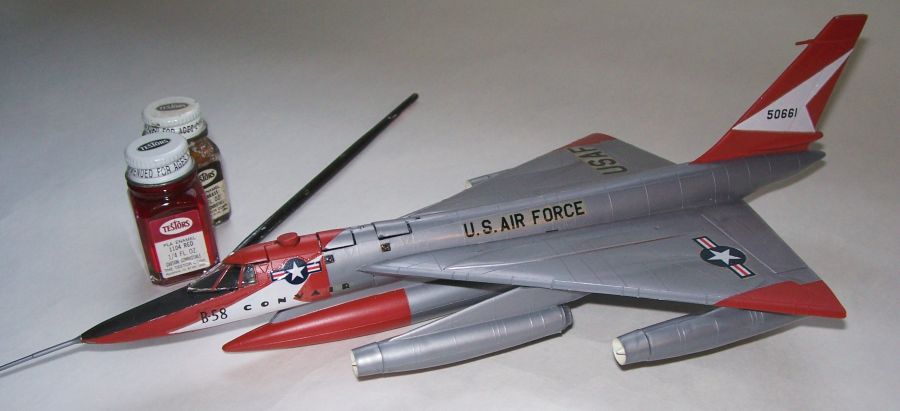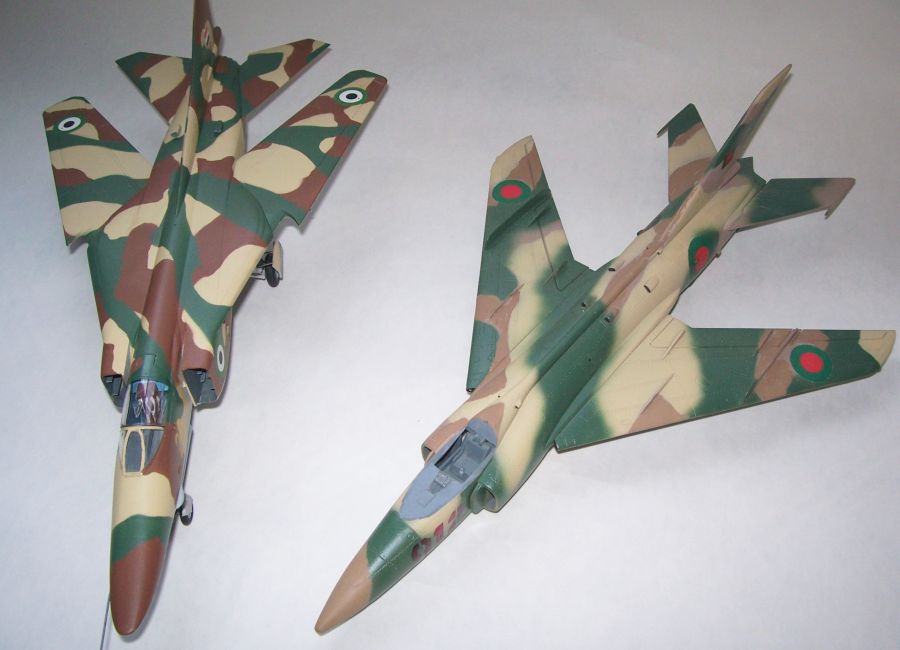
To discuss one of the most significant technological achievements of the late 20th-century, we need to go back and consider the epochal event of late May, 1962. That's when I had my 11th birthday party, and was given a model airplane kit: the Monogram B-58 Hustler "with Weapons Pod Release Action!"
I was not, on that day, entirely unfamiliar with model kits. On a handful of previous birthdays and Christmases, some well-meaning relative or another had given me one. On the first free evening that followed, Father would glue it together while I sat and watched, and then possibly helped dip the decals in water. What more was there?
But after this birthday party, I made a formal resolution. I would assemble this kit all by myself. Furthermore, I would do a GOOD job, including painting it!
Fortunately, I did not have to gather up my slender financial resources and go shopping for paint. My mother owned a small assortment of Testors’ enamels. Not quite sure why: she wasn't into tole painting or anything like that. She painted in oils, on canvas, in the classic artist’s fashion. I think she used the little enamel bottles from time to time to touch up some household item, or even one of our kids' toys, that had a paint chip or scratch.
Whatever her original purpose for them was, I became their de facto owner and user. It's likely they were bought as a set, because they were ‘complete’: black, white, silver, gold, and the most common colors: red, blue, orange, yellow, brown, and green. I needed no others to start my modeling career.
In fact, the Monogram kit had a great decal set, with the Convair logo all done in black and white. All I needed to paint was the red nose and tail, the black anti-glare panel and tires, plus a bit of brown on the three crew members’ G-suits.

I was quite happy and proud about how the kit came out. (But it’s been lost and gone forever; the picture here is of a rebuild, a ‘NABBROKE’: a ‘Nostalgic Aging Baby Boomer Real Old Kit Experience’.) Subsequent kit builds got pretty much the same kind of treatment. I would paint a little trim here and there, put a little black and silver on landing gear and other equipment, do the pilot’s suit in brown, and somewhere along the way I acquired a bottle of ‘flesh color’ for the pilot’s face. For a very long time, though, I would leave kits in the overall color they were molded in. It didn’t even begin to occur to me that they ought to be painted entirely.
Till the day, as I've described previously, that I routinely visited the Thunderbird Drug Store, and found there a dozen kits in the AirFix/72 series of World War II warplanes. These were molded in plain silver gray, and obviously needed full painting if they were to be shown in the keen pugnacious camouflage schemes of the fightin’-and-shootin’ box art.
I do wonder if the Fates include a sister who specifically watches over the lives of modelers, intervening at just the right times. You see, hard on the heels of my ‘discovery’ of the Airfix/72 line was a significant addition to the paints in the model kit and toy section at Thunderbird. There had always been a rack of additional Testors’ enamels, and I recall buying light blue, dark green, and an additional shade of brown. But they weren’t quite right; weren’t sinister or ‘martial’ enough.
Then one day, there was a whole paint set: Testors’ Military Flats. Olive drab, flat white, light gray, matt Navy blue, and a couple of shades of green and brown for camouflage schemes. (I’m working from memory here, but I see the set is still in production; a bit more expensive now, but still quite reasonable when you consider inflation over 50 years!) Anyway, it enabled me to start approaching the Airfix box art!
Interlude: the Dark Ages. Or at least, my own. The last kit I put those military flats on was the AMT 1/72 scale Junkers Ju-88 bomber. That was assembled at the dorm at the University of Washington, before my homework and other activities there consumed all my time. Thereafter came graduation, first job, marriage, moving, divorce…we won’t go into what all happened during the long interlude between that Ju-88 Then, and ‘Now’ times. It's probably a stereotypical rehash, much like what many of you readers can recall of your own lives.
But one odd thing: I never lost my willingness to step into a hobby shop and look at the toys there. One day, years after I’d left the UW as a student, I was back in the U-District, walking home from my short, disastrous job at Safeco. I took a slightly different way home to my apartment, realized University Hobbies was still open, and went in to browse a bit. There on a counter near the front of the store was a box: "Sale! Polly-S Colors water-base acrylic paints. Half Off Selected Colors!"
Water-based hobby paints? That sounded useful. Back at the U, Ken Murphy had explained to me that some artists were now painting in acrylics, which could be used much like oil paints, but dried quicker and didn’t stink up the art studio and environs. Now, apparently modelers didn't have to stink up their work tables with enamel and laquer fumes... how convenient! How technology marches on! I decided right then and there to buy some of these acrylics, and try them, sometime…
To Be Continued! In the meantime,
Build What You Want, the Way You Want To, and above all, Have Fun!
